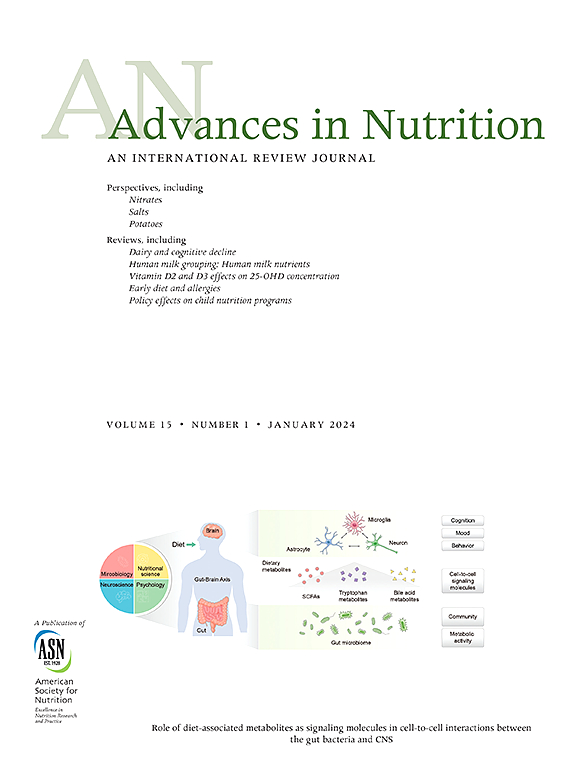The Effect of Red Meat Consumption on Circulating, Urinary, and Fecal Trimethylamine-N-Oxide: A Systematic Review and Narrative Synthesis of Randomized Controlled Trials
IF 9.2
1区 医学
Q1 NUTRITION & DIETETICS
引用次数: 0
Abstract
Cardiovascular concerns exist about the effect of red meat on circulating concentrations of trimethylamine N-oxide (TMAO), an emerging cardiovascular disease risk factor. The aim was to conduct a systematic review of randomized controlled trials (RCTs) to evaluate the effect of higher red meat intake, compared with lower intake, on circulating, urinary, and fecal TMAO concentrations in generally healthy adults and/or adults with stable chronic diseases. A systematic literature search was conducted using PubMed, the Cochrane Collaboration Library, and Web of Science. RCTs examining the effect of a ≥7-d dietary intervention featuring red meat on urinary, fecal, and/or circulating (plasma or serum) concentrations of TMAO in adults (≥18 y) were included. Eligible trials had a comparator group/condition that was exposed to a dietary intervention for ≥ 7 d lower in red meat and featuring white meat, fish, eggs, dairy, or plant-based protein sources. In total, 375 publications were identified. Fifteen publications reporting the results of 13 RCTs (n = 553; median duration 28 d), including 15 diet comparisons, were eligible. In 6 comparisons, higher circulating or urinary TMAO concentrations were observed after higher red meat intake (∼71–420 g/d) compared with comparator conditions lower in red meat. In 7 comparisons, no differences in serum/plasma TMAO concentrations were observed with higher red meat-containing diets (∼60–156 g/d) compared with diets lower in red meat. Two comparisons showed that consuming higher red meat diets lowered TMAO concentrations after 28 d compared with lower red meat diets containing seafood. In short-term studies (median duration of 28 d), higher red meat intake had inconsistent effects on circulating and urinary TMAO concentrations. Further high-quality research on red meat-related TMAO modulation, including effect magnitude and clinical relevance, is needed. This study was registered at Prospective Register of Systematic Reviews (PROSPERO) as CRD42023396799.
食用红肉对循环、尿液和粪便三甲胺- n -氧化物的影响:随机对照试验的系统评价和叙事综合。
背景:人们对红肉对循环中三甲胺n -氧化物(TMAO)浓度的影响存在担忧,TMAO是一种新兴的心血管危险因素。目的:本研究旨在对随机对照试验(rct)进行系统回顾,以评估与低摄入量相比,高红肉摄入量对一般健康成年人和/或患有稳定慢性疾病的成年人血液、尿液和粪便中氧化三甲胺浓度的影响。方法:使用PubMed、Cochrane协作图书馆和Web of Science进行系统文献检索。纳入了以红肉为特征的≥7天饮食干预对成人(≥18岁)尿液、粪便和/或循环(血浆或血清)氧化三甲胺浓度影响的随机对照试验。符合条件的试验有一个对照组/条件,该组/条件暴露于饮食干预≥7天,减少红肉,以白肉、鱼、蛋、乳制品或植物性蛋白质来源为主。结果:共发现375篇文献。15篇文献报道了13项随机对照试验的结果(n=553;中位持续时间28天),包括15个饮食比较,符合条件。在六项比较中,与红肉摄入量较低的对照条件相比,红肉摄入量较高(~ 71-420 g/天)后,观察到较高的循环或尿液TMAO浓度。在七项比较中,与低红肉饮食相比,高红肉饮食(~ 60-156 g/天)的血清/血浆TMAO浓度没有差异。两项比较表明,28天后,食用较多红肉的小鼠与食用较少含海鲜的红肉小鼠相比,氧化三甲胺浓度降低。结论:在短期研究中(中位持续时间为28天),摄入更多红肉对循环和尿中氧化三甲胺浓度的影响不一致。需要对红肉相关的氧化三甲胺调节进行进一步的高质量研究,包括效果大小和临床相关性。意义说明:本系统综述总结了与低摄入量红肉相比,高摄入量红肉对一般健康成人和/或患有稳定慢性疾病的成人血液、尿液和粪便中三甲胺n -氧化物(TMAO)浓度影响的证据。较高的红肉摄入量对氧化三甲胺浓度的影响不一致,这可能部分与临床试验方法的差异、饮食相关的氧化三甲胺调节的个体差异和/或含红肉饮食的整体健康状况有关。
本文章由计算机程序翻译,如有差异,请以英文原文为准。
求助全文
约1分钟内获得全文
求助全文
来源期刊

Advances in Nutrition
医学-营养学
CiteScore
17.40
自引率
2.20%
发文量
117
审稿时长
56 days
期刊介绍:
Advances in Nutrition (AN/Adv Nutr) publishes focused reviews on pivotal findings and recent research across all domains relevant to nutritional scientists and biomedical researchers. This encompasses nutrition-related research spanning biochemical, molecular, and genetic studies using experimental animal models, domestic animals, and human subjects. The journal also emphasizes clinical nutrition, epidemiology and public health, and nutrition education. Review articles concentrate on recent progress rather than broad historical developments.
In addition to review articles, AN includes Perspectives, Letters to the Editor, and supplements. Supplement proposals require pre-approval by the editor before submission. The journal features reports and position papers from the American Society for Nutrition, summaries of major government and foundation reports, and Nutrient Information briefs providing crucial details about dietary requirements, food sources, deficiencies, and other essential nutrient information. All submissions with scientific content undergo peer review by the Editors or their designees prior to acceptance for publication.
 求助内容:
求助内容: 应助结果提醒方式:
应助结果提醒方式:


